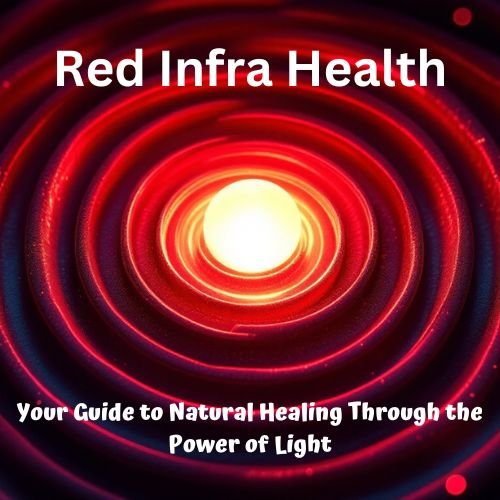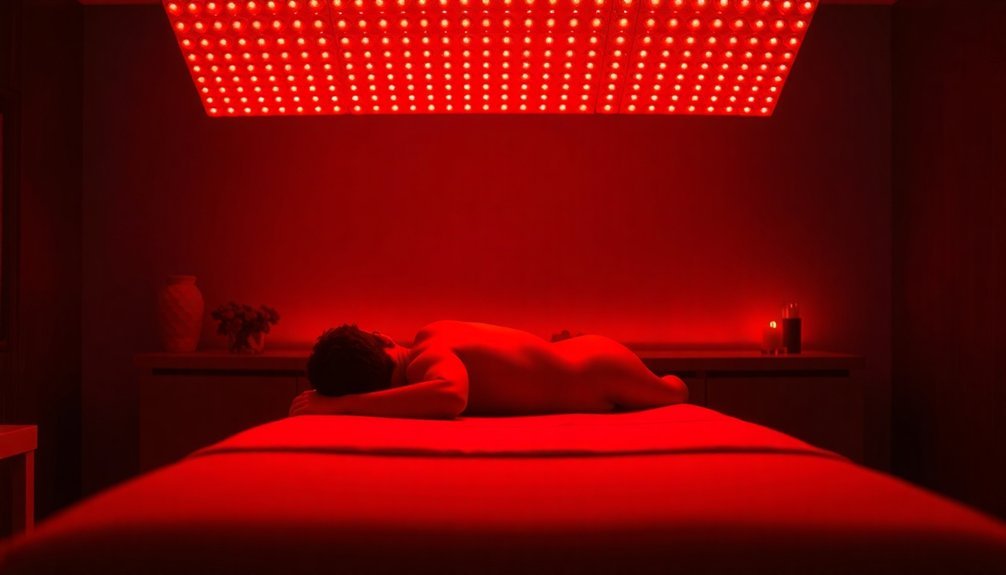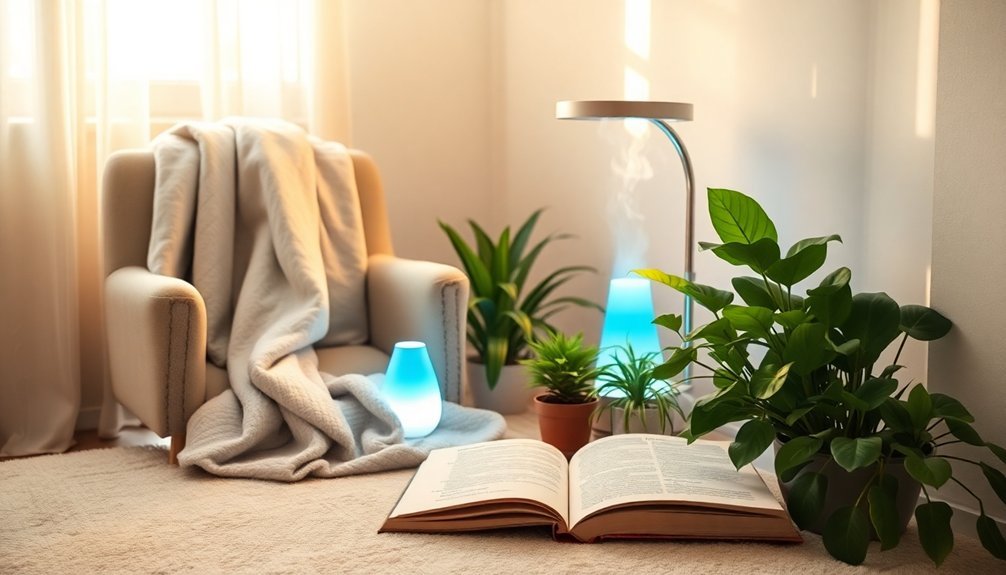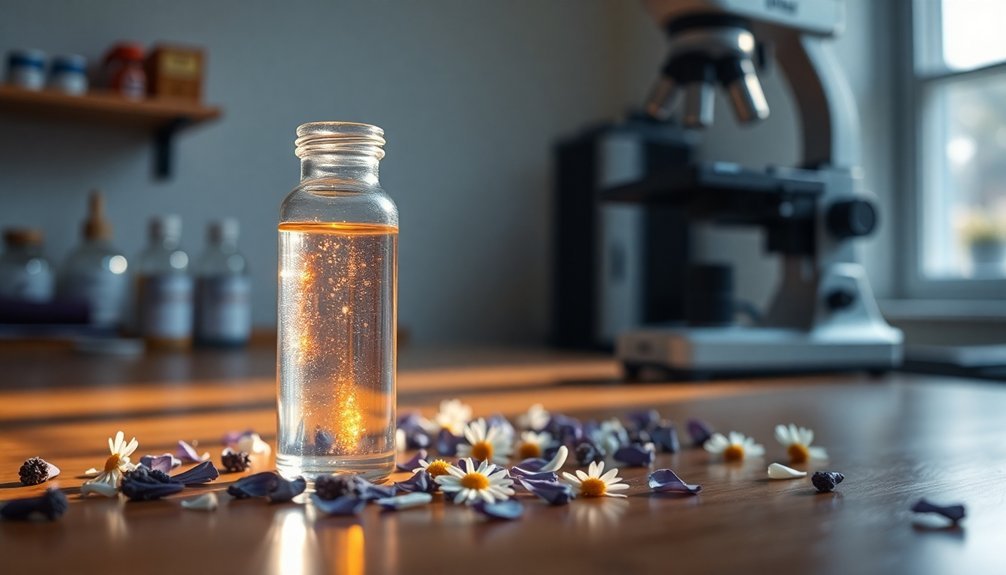LED light therapy can cut your recovery time in half through scientifically proven healing mechanisms. You'll experience increased blood flow and enhanced cell regeneration as the therapy stimulates your mitochondria – your cells' power generators. For athletes, this means returning to play in just 9.6 days versus 19.23 days without treatment. The therapy reduces inflammation, accelerates wound healing, and minimizes muscle fatigue through improved energy production at the cellular level. Red and near-infrared light wavelengths work together to boost your body's natural healing processes. Understanding these specific biological effects will transform how you approach recovery.
Scientific Evidence Behind Light Sessions

Research into LED light therapy reveals compelling evidence for its effectiveness across multiple applications. Studies show remarkable improvements in musculoskeletal injuries, with patients experiencing 40% better recovery compared to control groups. The therapy utilizes semiconductor technology that emits specific wavelengths of light through electroluminescence.
When it comes to laceration healing, LED therapy accelerates recovery by 50%.
When it comes to skin conditions, the evidence is particularly strong. Clinical trials demonstrate significant reduction in acne vulgaris using red and blue LED lights, with a standardized mean difference of -2.42.
You can expect substantial improvements in wrinkles, with studies reporting a 45% reduction after red light treatments. The therapy also proves effective for psoriasis when using near-infrared and yellow LEDs.
The benefits extend to overall skin health, where you'll see measurable improvements in texture, elasticity, and hydration. Research confirms that red light stimulates collagen and elastin production, leading to a remarkable 90% reduction in facial pore size.
These findings aren't just laboratory results – they're backed by real-world applications, including successful treatments by U.S. Navy crews and veterinary practices worldwide.
Healing Mechanisms Through LED Therapy
Through a process called photobiomodulation, LED light therapy triggers multiple healing mechanisms in your body's cells. When specific wavelengths of light penetrate your tissue, they activate cellular metabolism and stimulate natural repair processes.
Your body responds to these light signals by increasing blood flow, reducing inflammation, and accelerating tissue regeneration. Studies consistently show that LED therapy helps create painless healing outcomes without any side effects.
Different wavelengths offer unique benefits for your recovery. Red light (660 nm) boosts collagen production and promotes tissue repair, while infrared light reaches deeper tissues to modulate inflammation.
You'll find that LED therapy works through several key mechanisms:
- Stimulates your cells to produce more ATP (cellular energy), enhancing their ability to repair and regenerate
- Increases nitric oxide release, improving blood flow and oxygen delivery to damaged tissues
- Activates specific enzymes that control inflammation and cellular repair processes
- Promotes collagen synthesis, strengthening tissue structure and improving skin texture
Your body's healing response to LED therapy isn't just temporary – it continues working hours after your session ends. This sustained effect helps optimize your recovery process while maintaining a high safety profile compared to more invasive treatments.
Recovery Speed After Athletic Performance

When seeking peak athletic performance, LED light therapy emerges as a game-changing recovery tool that substantially reduces downtime between training sessions. You'll see remarkable differences in recovery speed, as athletes using LED therapy return to play in just 9.6 days compared to 19.23 days without treatment.
The therapy's effectiveness stems from its ability to accelerate muscle recovery through multiple pathways. LED therapy sessions activate muscle stem cells for optimal tissue repair. You'll experience reduced muscle soreness and fatigue while benefiting from enhanced blood circulation and collagen production.
The light penetrates your tissues, triggering cellular responses that combat inflammation and promote faster healing.
You'll notice the difference in your training routine as LED therapy outperforms traditional active recovery methods. While active recovery requires 6-10 minutes of movement, LED therapy works passively at the cellular level, stimulating your mitochondria to boost energy production and reduce oxidative stress.
This process enhances your body's natural recovery mechanisms, clearing toxins more efficiently and delivering essential nutrients to your muscles.
For superior results, you'll want to incorporate LED therapy into your regular recovery routine, as consistent use shows improved physical performance and faster return-to-play times.
Injury Prevention and Repair
Beyond faster recovery times, LED light therapy offers powerful protection against athletic injuries while accelerating the healing process. Studies show that 830 nm LED phototherapy substantially reduces recovery time for musculoskeletal injuries while promoting the growth of skin, bone, and muscle cells.
If you're dealing with sports-related injuries, here's what LED therapy can do for you:
- Cut your healing time in half – athletes using LED therapy return to play in 9.6 days compared to 19.23 days with conventional treatments
- Reduce pain dramatically – experience up to 6 points of pain reduction on the VAS scale within just 2-6 sessions
- Treat multiple injury types – from sprains and strains to ligament damage and tendonitis
- Provide safe, proven results – studies of 395 injuries showed no adverse effects
You'll find LED therapy particularly effective for oxygen-deprived wounds, with success rates 40% higher than control groups.
The technology's versatility allows for multiple wavelengths and larger treatment areas, making it an ideal choice for various injuries.
With 78.5% of athletes reporting satisfaction with their treatment, LED therapy's effectiveness in injury prevention and repair is well-documented.
Treatment Protocols for Athletes

Red light therapy delivers powerful results when athletes follow specific treatment protocols designed to maximize recovery and performance. You'll experience significant reductions in recovery time, with studies showing athletes returning to play in just 9.6 days compared to the usual 19.23 days. By targeting your muscles at the cellular level, this non-invasive treatment enhances blood flow and stimulates collagen production.
For ideal results, you'll want to incorporate 10-15 minute sessions either before or after your workouts. Regular use strengthens your mitochondrial function, boosting energy production and improving endurance without any adverse effects.
| Recovery Benefits | Performance Enhancement |
|---|---|
| 50% faster healing time | Increased ATP production |
| Reduced muscle soreness | Enhanced endurance |
| Improved circulation | Better oxygen delivery |
| Decreased inflammation | Faster toxin removal |
| Accelerated tissue repair | Stronger energy output |
Your body responds to red light therapy through multiple mechanisms, including reduced oxidative stress and improved cellular healing. Whether you're a professional athlete or weekend warrior, you'll find this treatment easily integrates into your routine, offering a painless way to enhance your recovery and boost overall athletic performance.
Frequently Asked Questions
Can LED Therapy Sessions Interfere With Sleep Patterns or Circadian Rhythms?
Yes, LED therapy can affect your sleep patterns – timing matters. You'll want morning sessions to advance your sleep cycle or evening sessions to delay it, as the light directly influences your circadian rhythms.
Is LED Therapy Safe to Use With Prescription Medications or Skin Products?
You'll need to avoid LED therapy if you're using steroids, anti-inflammatories, or Accutane. While most topical products are safe, always tell your provider about your medications to prevent potential interactions.
How Long Should the Break Be Between Multiple LED Therapy Sessions?
You'll need 24-48 hours between LED sessions for basic skin maintenance. If you're treating acne, you can do 2-3 sessions weekly, while anti-aging treatments work best with 1-2 week intervals.
Does Skin Tone or Thickness Affect the Effectiveness of LED Therapy?
Yes, your skin tone and thickness can affect LED therapy's effectiveness. You'll need adjusted wavelengths for darker skin, while thicker skin may require deeper-penetrating wavelengths to achieve ideal results during treatment.
Can LED Therapy Help With Old Scars and Chronic Injuries?
Yes, you'll find LED therapy can help reduce old scars and chronic injuries. It works by boosting collagen production, improving blood flow, and reducing inflammation. The treatment's particularly effective with consistent, long-term use.
In Summary
You'll find LED light therapy to be a proven method for faster recovery and healing. Whether you're an athlete or fitness enthusiast, regular LED sessions can cut down your recovery time and reduce inflammation. Start with short sessions and gradually increase duration based on your needs. By incorporating this science-backed treatment into your routine, you'll experience enhanced muscle repair and reduced downtime between workouts.





Leave a Reply